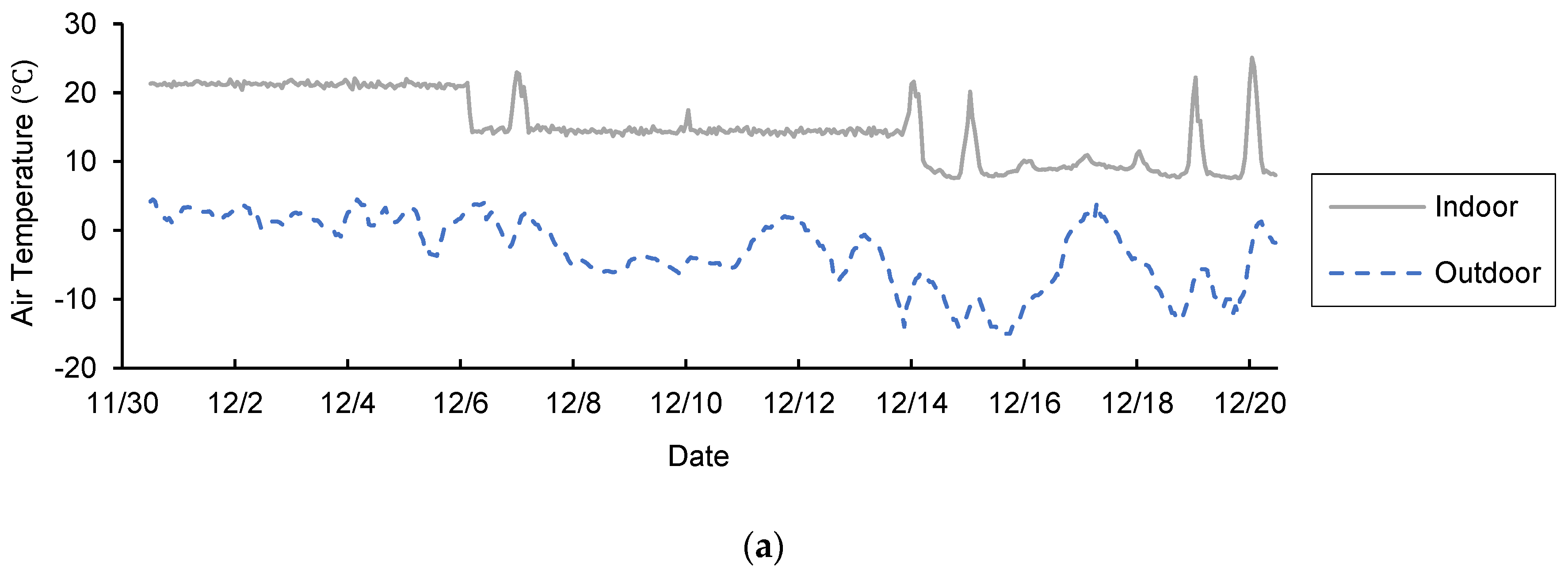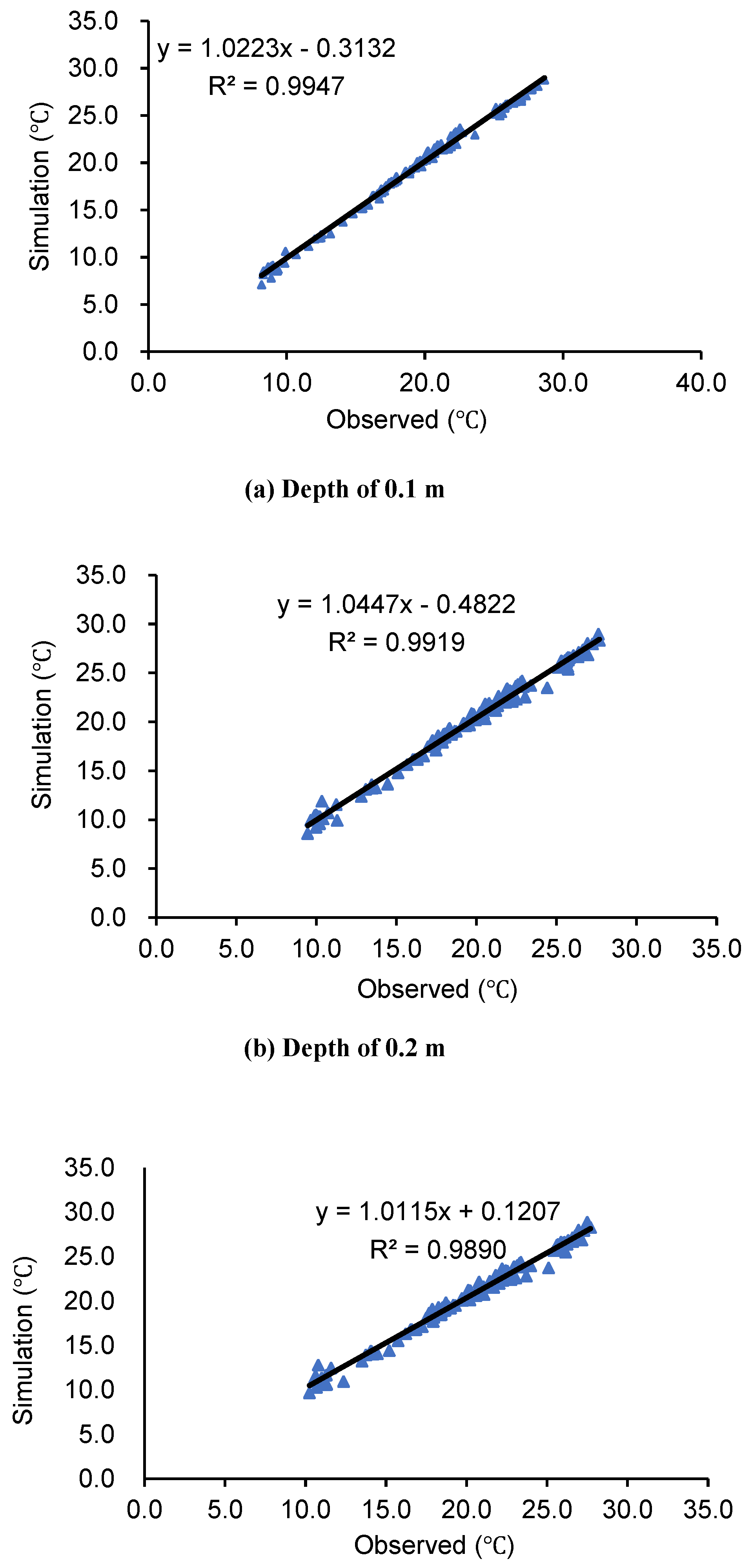Estimation of Thermal Diffusivity for Greenhouse Soil Temperature Simulation
Abstract
1. Introduction
2. Materials and Methods
2.1. Theory of Soil Temperature Simulation
- t is the time of day, h;
- is the average temperature at the soil surface, °C;
- is the amplitude of the soil surface temperature fluctuation, °C;
- is the phase shift, the delay of soil surface temperature change at soil surface, h;
- is the radial frequency and is expressed aswhere is the period of temperature fluctuation and is set to 24 h.
- is the average temperature at the soil depth , °C;
- is the soil thermal transfer phase shift, the delay between the soil surface and depth ;
- and are defined as [8]
- is the density of the soil, kg m−3
- c is the soil specific heat, J kg1 K−1
- is the volumetric heat capacity, J m−3 K−1
2.2. Soil Thermal Diffusivity Estimation Methods
2.2.1. Amplitude Method and Phase-Shift Method
2.2.2. Arctangent Method and Logarithmic Method
2.2.3. Min-Max Method
2.3. Data Collection
3. Results and Discussion
3.1. Analysis of Greenhouse Data
3.1.1. Cooling Season
3.1.2. Heating Season
3.1.3. Daily Average Temperature
3.2. Calculation of Soil Thermal Diffusivity
3.3. Greenhouse Soil Temperature Simulation
3.3.1. Average Soil Temperature Simulation
3.3.2. Simulation of the Diurnal Variation of Soil Temperature
4. Discussion
5. Conclusions
Author Contributions
Funding
Acknowledgments
Conflicts of Interest
References
- Sanford, S. Reducing greenhouse energy consumption—An overview. Energy Effic. Greenh. 2011, 3907, 1–16. [Google Scholar]
- Sethi, V.P.; Sharma, S.K. Survey and evaluation of heating technologies for worldwide agricultural greenhouse applications. Sol. Energy 2008, 82, 832–859. [Google Scholar] [CrossRef]
- Vadiee, A.; Martin, V. Energy analysis and thermo economic assessment of the closed greenhouse—The largest commercial solar building. Appl. Energy 2013, 102, 1256–1266. [Google Scholar] [CrossRef]
- Du, J.; Bansal, P.; Huang, B. Simulation model of a greenhouse with a heat-pipe heating system. Appl. Energy 2012, 93, 268–276. [Google Scholar] [CrossRef]
- Anifantis, A.S.; Colantoni, A.; Pascuzzi, S. Thermal energy assessment of a small scale photovoltaic, hydrogen and geothermal stand-alone system for greenhouse heating. Renew. Energy 2017, 103, 115–127. [Google Scholar] [CrossRef]
- Ghosal, M.K.; Tiwari, G.N. Modeling and parametric studies for thermal performance of an earth to air heat exchanger integrated with a greenhouse. Energy Convers. Manag. 2006, 47, 1779–1798. [Google Scholar] [CrossRef]
- Horton, R.; Wierenga, P.J. Estimating the Soil Heat Flux from Observations of Soil Temperature Near the Surface. Soil Sci. Soc. Am. J. 1983, 47, 14–20. [Google Scholar] [CrossRef]
- Ozgener, O.; Ozgener, L.; Tester, J.W. A practical approach to predict soil temperature variations for geothermal (ground) heat exchangers applications. Int. J. Heat Mass Transf. 2013, 62, 473–480. [Google Scholar] [CrossRef]
- Danelichen, V.H.M.; Biudes, M.S.; Souza, M.C.; Machado, N.G.; Curado, L.F.A.; Nogueira, J.S. Soil Thermal Diffusivity of a Gleyic Solonetz Soil Estimated by Different Methods in the Brazilian Pantanal. Open J. Soil Sci. 2013, 3, 15–22. [Google Scholar] [CrossRef]
- Li, Y.; Liu, S.; Wang, S.; Miao, Y.; Chen, B. Comparative study on methods for computing soil heat storage and energy balance in arid and semi-arid areas. J. Meteorol. Res. 2014, 28, 308–322. [Google Scholar] [CrossRef]
- Awe, G.O.; Reichert, J.M.; Wendroth, O.O. Temporal variability and covariance structures of soil temperature in a sugarcane field under different management practices in southern Brazil. Soil Tillage Res. 2015, 150, 93–106. [Google Scholar] [CrossRef]
- An, K.; Wang, W.; Zhao, Y.; Huang, W.; Chen, L.; Zhang, Z.; Wang, Q.; Li, W. Estimation from Soil Temperature of Soil Thermal Diffusivity and Heat Flux in Sub-surface Layers. Bound. Layer Meteorol. 2016, 158, 473–488. [Google Scholar] [CrossRef]
- Yener, D.; Ozgener, O.; Ozgener, L. Prediction of soil temperatures for shallow geothermal applications in Turkey. Renew. Sustain. Energy Rev. 2017, 70, 71–77. [Google Scholar] [CrossRef]
- De Silans, A.M.B.P.; Monteny, B.A.; Lhomme, J.P. Apparent soil thermal diffusivity, a case study: HAPEX-Sahel experiment. Agric. Forest Meteorol. 1996, 81, 201–216. [Google Scholar] [CrossRef]
- Horton, R.; Wierenga, P.J.; Nielsen, D.R. Evaluation of methods for determining the apparent thermal diffusivity of soil near the surface. Soil Sci. Soc. Am. J. 1983, 47, 25–32. [Google Scholar] [CrossRef]
- Nerpin, S.V.; Chudnovskii, A.C. Physics of the Soil: Israel Program for Scientific Translations; Keter Press: Jerusalem, Israel, 1967. [Google Scholar]
- Seemann, J. Measuring Technology. In Agrometeorology; Springer: Berlin/Heidelberg, Germany, 1979; pp. 40–45. [Google Scholar]
- Campbell, G.S.; Norman, J.M. An Introduction to Environmental Biophysics, 2nd ed.; Springer: Berlin, Germany, 1998. [Google Scholar]
- Sharma, P.K.; Tiwari, G.N. Parametric study of a greenhouse by using Runge–Kutta methods. Energy Convers. Manag. 1999, 40, 901–912. [Google Scholar] [CrossRef]
- Kang, S.; Kim, S.; Oh, S.; Lee, D. Predicting spatial and temporal patterns of soil temperature based on topography, surface cover and air temperature. For. Ecol. Manag. 2000, 136, 173–184. [Google Scholar] [CrossRef]
- Otunla, T.; Otunla, T.A.; Oladiran, E.O. Evaluation of soil thermal diffusivity algorithms at two equatorial sites in West Africa. Ann. Geophys. 2013, 56, R0101. [Google Scholar] [CrossRef]
- Sethi, V.P.; Sharma, S.K. Experimental and economic study of a greenhouse thermal control system using aquifer water. Energy Convers. Manag. 2007, 48, 306–319. [Google Scholar] [CrossRef]
- Zheng, D.; Hunt, E.R.; Running, S.W. A daily soil temperature model based on air temperature and precipitation for continental applications. Clim. Res. 1993, 2, 183–191. [Google Scholar] [CrossRef]
- Hu, Q.; Feng, S. A daily soil temperature dataset and soil temperature climatology of the contiguous United States. J. Appl. Meteorol. 2003, 42, 1139–1156. [Google Scholar] [CrossRef]
- Kätterer, T.; Andrén, O. Predicting daily soil temperature profiles in arable soils in cold temperate regions from air temperature and leaf area index. Acta Agric. Scand. Sect. B Soil Plant Sci. 2009, 59, 77–86. [Google Scholar] [CrossRef]
- Paul, K.I.; Polglase, P.J.; Smethurst, P.J.; O’Connell, A.M.; Carlyle, C.J.; Khanna, P.K. Soil temperature under forests: A simple model for predicting soil temperature under a range of forest types. Agric. For. Meteorol. 2004, 121, 167–182. [Google Scholar] [CrossRef]
- Tabari, H.; Sabziparvar, A.A.; Ahmadi, M. Comparison of artificial neural network and multivariate linear regression methods for estimation of daily soil temperature in an arid region. Meteorol. Atmos. Phys. 2011, 110, 135–142. [Google Scholar] [CrossRef]
- Joudi, K.A.; Farhan, A.A. A dynamic model and an experimental study for the internal air and soil temperatures in an innovative greenhouse. Energy Convers. Manag. 2015, 91, 76–82. [Google Scholar] [CrossRef]
- Sethi, V.P.; Sumathy, K.; Lee, C.; Pal, D.S. Thermal modeling aspects of solar greenhouse microclimate control: A review on heating technologies. Sol. Energy 2013, 96, 56–82. [Google Scholar] [CrossRef]
- Ghasemi Mobtaker, H.; Ajabshirchi, Y.; Ranjbar, S.F.; Matloobi, M. Solar energy conservation in greenhouse: Thermal analysis and experimental validation. Renew. Energy 2016, 96, 509–519. [Google Scholar] [CrossRef]
- Taki, M.; Ajabshirchi, Y.; Ranjbar, S.F.; Rohani, A.; Matloobi, M. Modeling and experimental validation of heat transfer and energy consumption in an innovative greenhouse structure. Inf. Process. Agric. 2016, 3, 157–174. [Google Scholar] [CrossRef]













| Date | Environmental Conditions | Amplitude | Phase Shift | Arctangent | Logarithmic | Min-Max |
|---|---|---|---|---|---|---|
| 9/1 | Cloudy sky, cooled | 9.53 | 7.74 | 9.14 | 12.71 | 10.58 |
| 9/2 | Clear sky, cooled | 8.95 | 12.69 | 11.02 | 8.19 | 10.03 |
| 9/3 | Clear sky, cooled | 9.17 | 12.74 | 12.95 | 7.46 | 10.28 |
| 9/4 | Clear sky, cooled | 9.49 | 11.37 | 12.56 | 8.68 | 10.03 |
| 9/5 | Clear sky, cooled | 9.38 | 11.36 | 11.01 | 8.35 | 9.27 |
| 9/6 | Clear sky, Uncooled | 9.21 | 12.08 | 11.51 | 8.38 | 10.53 |
| 9/7 | Clear sky, Uncooled | 9.58 | 14.34 | 11.85 | 7.82 | 11.05 |
| Average | 9.33 | 11.76 | 11.44 | 8.8 | 10.25 | |
| Standard Deviation | 0.23 | 2.04 | 1.25 | 1.77 | 0.56 | |
| Environmental Conditions | Soil Depth | |||
|---|---|---|---|---|
| 0.1 m | 0.2 m | 0.3 m | ||
| Cooling season | Clear sky (w/cooling) | 0.95 | 0.80 | 0.47 |
| Clear sky (w/o cooling) | 0.88 | 1.29 | 1.30 | |
| Rainy | 0.81 | 0.71 | 0.90 | |
| Heating season | Set point: 21 °C | 0.31 | 0.11 | 0.24 |
| Set point: 14.4 °C | 0.43 | 0.32 | 0.18 | |
| Set point: 4.4 °C | 0.25 | 0.12 | 0.24 | |
© 2020 by the authors. Licensee MDPI, Basel, Switzerland. This article is an open access article distributed under the terms and conditions of the Creative Commons Attribution (CC BY) license (http://creativecommons.org/licenses/by/4.0/).
Share and Cite
Wang, J.; Lee, W.F.; Ling, P.P. Estimation of Thermal Diffusivity for Greenhouse Soil Temperature Simulation. Appl. Sci. 2020, 10, 653. https://doi.org/10.3390/app10020653
Wang J, Lee WF, Ling PP. Estimation of Thermal Diffusivity for Greenhouse Soil Temperature Simulation. Applied Sciences. 2020; 10(2):653. https://doi.org/10.3390/app10020653
Chicago/Turabian StyleWang, Jizhang, Wee Fong Lee, and Peter P. Ling. 2020. "Estimation of Thermal Diffusivity for Greenhouse Soil Temperature Simulation" Applied Sciences 10, no. 2: 653. https://doi.org/10.3390/app10020653
APA StyleWang, J., Lee, W. F., & Ling, P. P. (2020). Estimation of Thermal Diffusivity for Greenhouse Soil Temperature Simulation. Applied Sciences, 10(2), 653. https://doi.org/10.3390/app10020653






